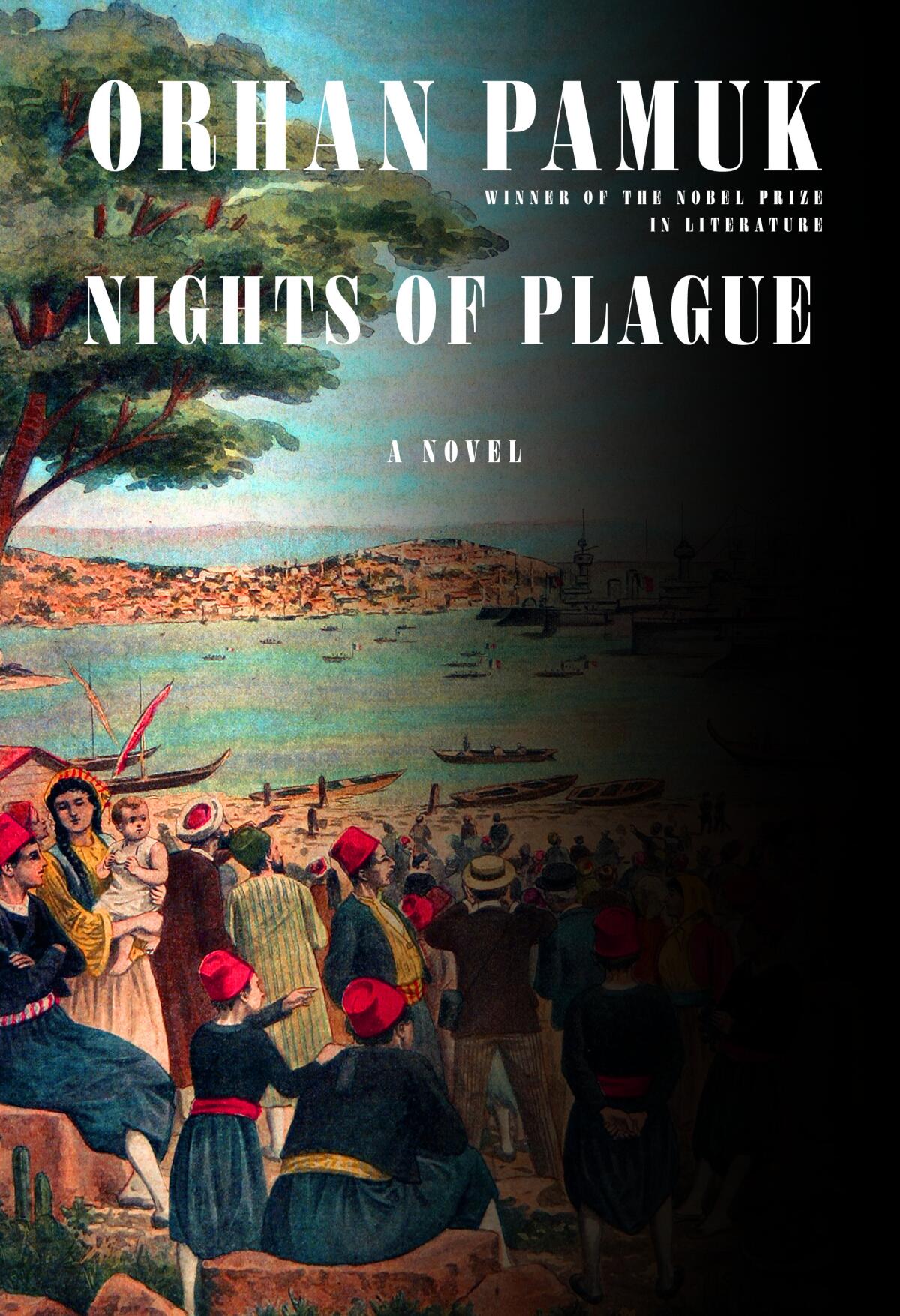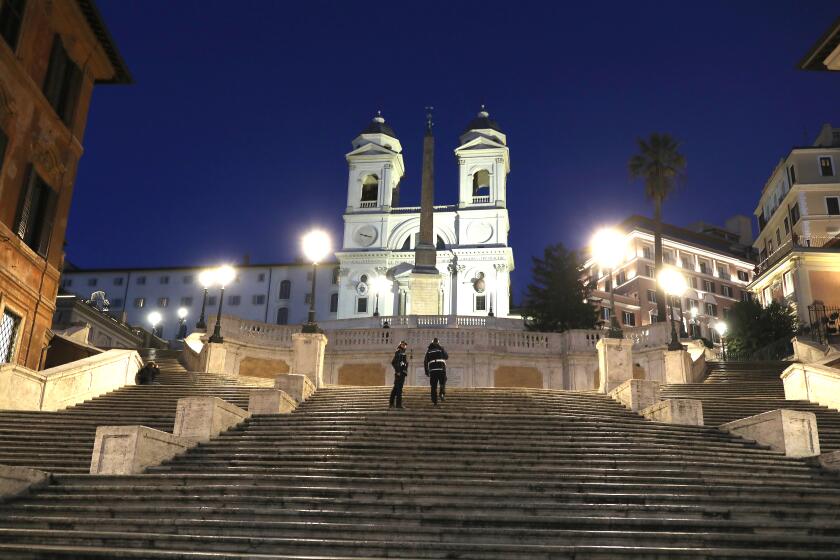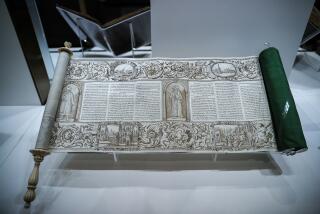Review: Orhan Pamuk’s ‘Nights of Plague’ entangles an epidemic with a (fictional) revolution

On the Shelf
Nights of Plague
By Orhan Pamuk
Translated by Ekin Oklap
Knopf: 704 pages, $34
If you buy books linked on our site, The Times may earn a commission from Bookshop.org, whose fees support independent bookstores.
In 2012, Orhan Pamuk, Turkey’s only Nobel laureate in literature, opened his Museum of Innocence in a 19th century wooden house in Istanbul. A real museum of imaginary lives, it contains 1,000 objects linked to the fictional characters in Pamuk’s 2008 novel of the same name. To understand how audacious this was, imagine buying a cavernous English manor, filling it with period artifacts and exhibiting it as Thornfield Hall, home of Edward Rochester and Jane Eyre.
“Nights of Plague,” Pamuk’s 11th — and longest — novel, is a real book about an imaginary place, Mingheria, an island in the eastern Mediterranean between Crete and Cyprus. Its population of 80,000 is divided evenly — and tensely — between Muslims and Greek Orthodox Christians. Like William Faulkner, who provided a map of his fictional Yoknapatawpha County, Pamuk places a map of Mingheria (capital: Arkaz) at the beginning of his book. In 1901, when the novel is set, Mingheria is a province within the crumbling Ottoman Empire, which the Western powers disdain as “the sick man of Europe.”
When a plague breaks out in Mingheria, so does the movement for independence from Sultan Abdul Hamid II, who would prove to be the last absolute Ottoman monarch. Like works by Albert Camus, Daniel Defoe and Alessandro Manzoni (whose “The Betrothed” provides an epigraph), this is a plague narrative, a record of Mingheria’s deadly yearlong ordeal. We track the daily collection of corpses and the truculent resistance to quarantine. But “Nights of Plague” is also an origin story, an account of how a proud island nation achieved its sovereignty. After more than 600 pages of struggle, strife and suffering, the novel’s final words proclaim: “Long live Mingheria! Long live Mingherians! Long live liberty!”
Orhan Pamuk’s L.A. stroll conjures up familiar sights
Central to the story are Princess Pakize and her consort, Doctor Nuri Bey. Pakize is the third daughter of Murad V, a former sultan who was deposed by the current one, his brother, and for years confined with his children to an Istanbul palace. Pakize’s tyrannical uncle arranged for her marriage to Nuri, a renowned epidemiologist, but a union of convenience soon becomes a passionate match. After Bonkowski Pasha, the Ottoman Empire’s chief inspector of public health and sanitation (and a Christian), is mysteriously murdered in the Muslim neighborhood of Arkata, Abdul Hamid II dispatches Nuri and Pakize to Mingheria to solve the case and quell the plague. Complicating their task are religious antagonisms and violent rivalries for power.

Like Camus’ “The Plague,” in which Dr. Bernard Rieux waits until the final pages to reveal that he is the one who has been telling the story, “Nights of Plague” is narrated by someone whose identity is withheld for most of the book. In recounting the birth of independent Mingheria, the narrator draws on 113 letters Pakize wrote to her older sister, Princess Hatice, and on archival material scattered across several countries.
Murad V and Abdul Hamid II are actual historical figures, but Pakize is not, and neither are the Mingherians. The scholarly narrator describes the manuscript produced as “both a historical novel and a history written in the form of a novel.” Confounding the two by conceding she is an imaginary historian, she proclaims at the outset: “I myself am a daughter of Mingheria.” And in a metafictional touch, this fictional child of a fictional island claims to have consulted with “the novelist and history enthusiast Orhan Pamuk.”
More than a century after the momentous events of 1901, the narrator enjoys visiting Mingherian patriots’ birthplaces that have since been turned into museums. And she observes: “This fondness for museums is another interest I share with the novelist Pamuk.”
Albert Camus’ “The Plague,” read in quarantine for the first time, warns us to reset our own priorities
A museum of imaginary history, “Nights of Plague” is stocked with stuff that a more frugal curator might choose to deaccession. Detailed descriptions of foods, pharmaceuticals and clothing in Arkata and disquisitions on Mingherian language add density to the prose. They furnish the work with artifacts of the communal experience while magnifying the duration of the nightmare. As transposed from the Turkish by Ekin Oklap, who also translated Pamuk’s “A Strangeness in My Mind” (2015) and “The Red-Haired Woman” (2017), the pages bear the weight of a fateful year.
However, they come in the form of exposition more often than dramatization. That is in part because our primary source of information, Princess Pakize, having grown up confined to her palace, is now forced, for her own safety, to spend most of the crucial year in seclusion. She is dependent on others, particularly her husband, for information about the ravages of disease and political violence that devastate the island. Her account is secondhand and indirect.
The narrator, sharing her research three generations after the fact, writes in the tepid voice of an archivist, not a poet. That is particularly true in the extended epilogue, in which she brings the reader up to date on actual historical developments, including the disintegration of the Ottoman Empire and the tumultuous rise of modern Turkey. Many Pamuk novels, including “The White Castle” (1985) and “My Name Is Red” (1998), are narrated by scholars, but this one muffles a story that should resonate loudly with the current pandemic.
In the film “Night at the Museum,” Ben Stiller, a security guard at the Museum of Natural History, undergoes a harrowing night in which the collection’s ancient predators come to life. It is safer — and more thrilling — to spend a week inside “Nights of Plague.”
Not so long ago, novelist Orhan Pamuk faced imprisonment in his homeland of Turkey.
Kellman’s books include “Redemption: The Life of Henry Roth” and “The Translingual Imagination.”
More to Read
Sign up for our Book Club newsletter
Get the latest news, events and more from the Los Angeles Times Book Club, and help us get L.A. reading and talking.
You may occasionally receive promotional content from the Los Angeles Times.







